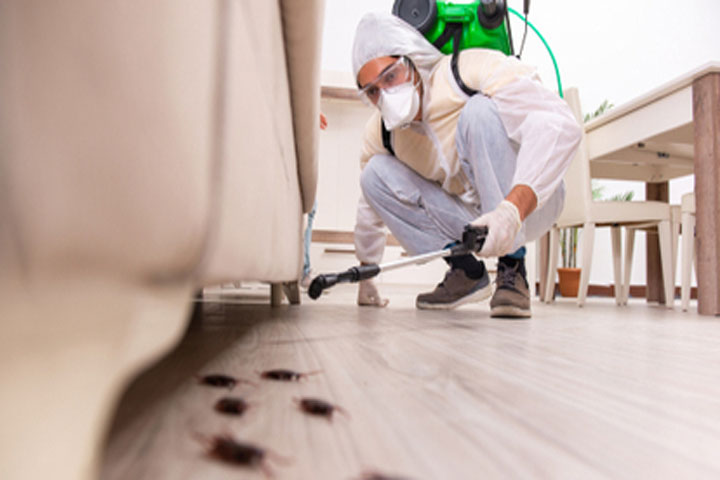Expert Insect Control Techniques for Long-Term Results
In the world of insect control, attaining continual effectiveness and long-lasting outcomes requires a meticulous approach that goes beyond simple extermination. Expert pest control methods encapsulate an extensive strategy that begins with a complete examination and analysis, complied with by precise insect recognition to recognize their habits patterns. The implementation of Integrated Bug Monitoring (IPM) concepts, coupled with eco-conscious therapies, forms the cornerstone of lasting parasite elimination. Nonetheless, real examination exists in the continuous monitoring and upkeep of the dealt with areas, guaranteeing a pest-free atmosphere for the direct future. By delving right into the ins and outs of these strategies, a deeper understanding of specialist parasite control techniques for withstanding end results arises.
Examination and Assessment
Upon entering a home for pest control services, the preliminary step is a thorough assessment and evaluation to identify the level of the problem and establish the most efficient therapy plan. Specialist insect control service technicians are educated to diligently check out the properties, looking for indicators of parasite task such as droppings, munch marks, nests, or any type of structural damages. They will also analyze the conditions that might be drawing in pests, such as food sources, water leaks, or entry points.

Bug Recognition and Habits

Additionally, comprehending the actions of the determined insect is crucial to executing effective control steps. Understanding where parasites nest, what they feed on, and their task patterns can aid pest control experts develop strategies to remove them effectively.
Integrated Parasite Monitoring (IPM)
Integrated Insect Administration (IPM) strategies combine numerous strategies to control and prevent parasite infestations in a lasting and eco-friendly fashion. bed bug treatment. By incorporating techniques such as biological control, habitat adjustment, adjustment of social techniques, and using resistant selections, IPM aims to lessen the usage of chemical pesticides
One of the key concepts of IPM is the focus on avoidance. This positive strategy involves surveillance insect populations routinely to spot any prospective issues prior to they rise. By identifying insect troubles early, pest control measures can be executed swiftly and successfully.
Additionally, IPM promotes the use of non-toxic bug control techniques whenever possible. This can include utilizing natural predators of the pests, presenting valuable bugs, or making use of scents to disrupt breeding patterns. By lowering dependence on chemical pesticides, IPM not just secures the environment but likewise aids maintain an equilibrium in the ecosystem.
Environmentally-Friendly Treatments
Implementing eco-conscious approaches in pest control procedures can successfully resolve problems while prioritizing ecological sustainability. Environmentally-friendly therapies concentrate on minimizing the impact of bug control methods on environments, non-target organisms, and human health and wellness. These techniques commonly involve using all-natural predators, such as ladybugs or nematodes, to regulate pest populaces, reducing the need for chemical treatments. Additionally, techniques like habitat control, such as adjusting moisture levels or eliminating food resources, can help deter insects without the usage of hazardous materials.
Another key element of environmentally-friendly therapies is the use of organic and eco-friendly items that damage down quickly without leaving dangerous deposits in the setting. Organic pesticides derived from plants like chrysanthemums or neem supply efficient insect control while posing minimal danger to non-target types. Employing techniques like warm therapies or pheromone catches can target specific parasites with accuracy, minimizing the total environmental impact of insect control techniques.
Continuous Surveillance and Upkeep
Normal inspections by skilled professionals are required to determine any type of indicators of pest task, evaluate the efficiency of previous therapies, and make adjustments to the bug control strategy as required. By keeping bed bug treatment track of parasite populaces over time, insect control specialists can track fads, prepare for potential issues, and apply precautionary steps to minimize the threat of future problems.
Along with tracking, upkeep practices are vital for long-term parasite control success. This consists of carrying out proper cleanliness procedures to remove prospective food and water sources for parasites, securing off access factors to stop parasites from getting in the premises, and resolving any structural concerns that can facilitate bug infestations (Pest control Washington DC). By including recurring surveillance and maintenance right into an integrated insect management method, businesses can guarantee a pest-free atmosphere and secure their building versus costly damages and health and wellness risks
Verdict
Finally, utilizing specialist parasite control methods such as thorough assessment and evaluation, exact insect identification and understanding of their behavior, integrated bug management strategies, environmentally-friendly treatments, and recurring surveillance and upkeep are essential for accomplishing long-lasting lead to insect control. By carrying out these techniques, individuals can effectively handle bug invasions and maintain a pest-free environment in a sustainable manner.